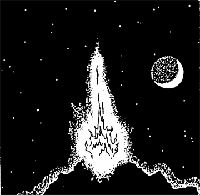![]()
Fire and Light:
An Introduction to
Christian Mysticism

... the Holy Spirit gives light
so that we may understand, and fire so
that we may love. (St. Bernard of
Clairvaux)
Theology is light; prayer is fire. Their union expresses the union of the intellect and the heart. But it is the intellect that must ‘repose’ in the heart, and theology must transcend it in love. (Olivier Clément)
Course Description:
We explore the meaning of these statements
through the history of Christian mysticism.
We look for the roots of Christian contemplation
in Christian scripture and the Desert Fathers
and Mothers. We examine the medieval richness
of the Golden Age, the 14th-century flowering,
the 16th-century Carmelite resurgence,
and the dialogical thrust of the 20th century.
We spend the third week of the course in
Crestone, Colorado, where we immerse ourselves
in the spirit of the desert and consider
the practical implications of what we study
in the classroom.
Topics include the relationship of darkness and light, contemplation and action, suffering and joy, agony and ecstasy, discipline and freedom, solitude and community. We examine different “types” or “schools” of mysticism, and explore the connection between the lives of the mystics and their writings. We consider the stages of spiritual growth, rooted in vibrant natural human experience, moving through religious and mystical experience into two distinctive dimensions of Christian prayer: monologistos prayer and the prayer of passion.
Method, Meeting Times,
and Office Hours:
We combine lectures and discussion, some
of which include playing the roles of various
mystics. Reading assignments are listed
below. Further photocopied readings may
be added where appropriate, with plenty
of lead-time. Classes meet at 9:00 a.m.-noon
Monday through Fridays. Each class roughly
includes a lecture, shared reflections
on The Quiet Eye and scripture, two 10-minute
breaks, dialogues with the mystics, discussion,
and occasional videos. Office hours are
by appointment.
Requirements and Grading:
You are responsible for careful reading
of and reflection on the assigned texts,
as well as active participation in classroom
discussion, which includes playing the
roles of various mystics.
Final grades are based one quarter on intelligent class participation that demonstrates familiarity with the reading assignments, one quarter on two weekly essays, and one half on the final, which is in two parts: an 8-10-page research paper followed by a 3-4-page essay. Tardiness and unannounced absences will not help your cause.
Please type all your essays and exams double-spaced in 12 pt. Times Roman type with margins of one inch. Staple and number the pages. If delivered to our office under the door, please place in an 8.5”x11” envelope.
We emphasize the importance of writing well and suggest you consult the Harbrace College Handbook (Horner/Webb/Miller, 12th edition, 1994). We are committed to correcting writing errors and expect improvement as a result.
Non-majors concerned with grade point averages may want to consider taking the class pass-fail, although previous non-majors have been among our best students, and some regret taking the class pass-fail.
BOOKS
Required Reading
- Bielecki, Tessa; Teresa of Avila: Ecstasy and Common Sense. Boston: Shambhala, 1996
- Egan, Harvey; An Anthology of Christian Mysticism. Collegeville: Pueblo, 1991
- Judson, Sylvia; The Quiet Eye. Washington, DC: Regnery, 1982
- Newsweek, March 29, 1999, "2000 Years of Jesus," by Kenneth Woodward
Fire and Light main page || Fire and Light photos || Syllabus next page